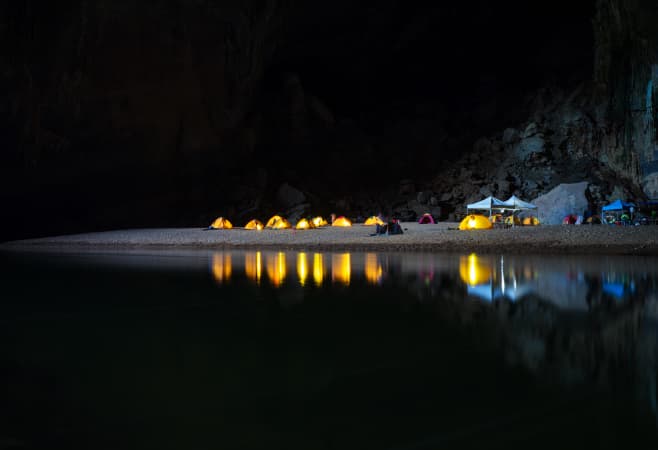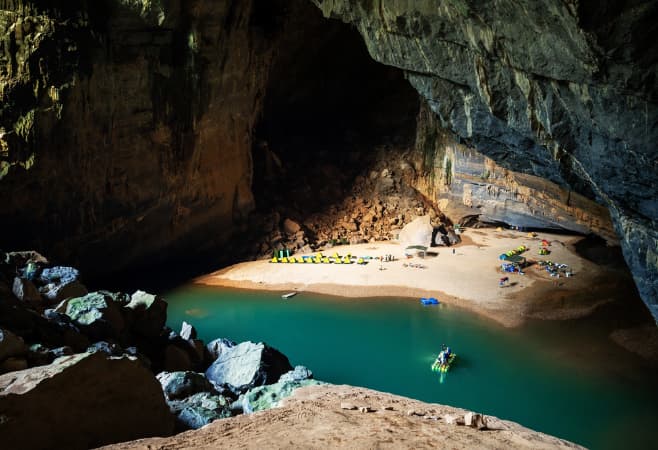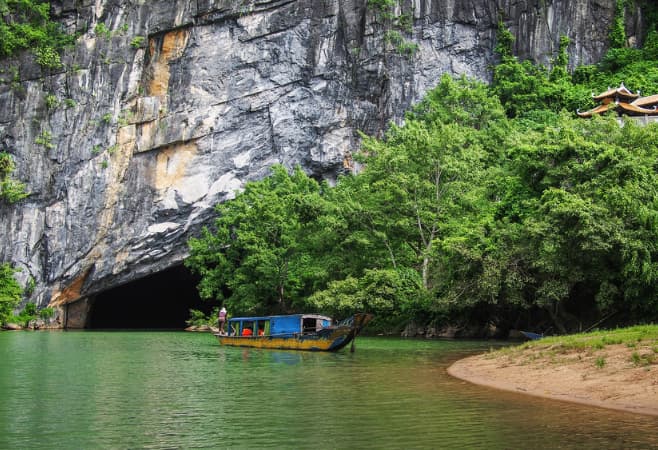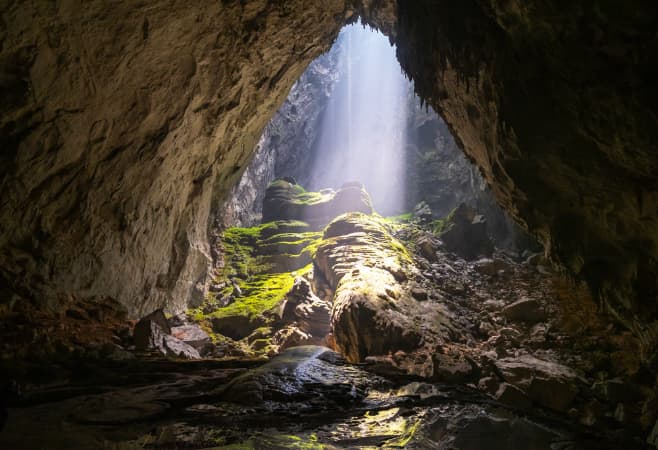Son Doong Cave: Explore the World's largest cave in Vietnam
Tucked beneath the ancient karst mountains of central Vietnam lies a subterranean world so vast and surreal, it almost defies logic. Son Doong cave or “Hang Sơn Đoòng", is no ordinary geological formation - it's the largest cave in the world and a natural masterpiece carved by time. Discovered only recently, it has swiftly captured the imagination of explorers, geologists and adventure travelers worldwide.
Why all the buzz? Picture a cave so colossal it houses a jungle, river and cloud system inside. It's so vast that entire city blocks with skyscrapers could comfortably fit within its cavernous halls. The cave is more than just a travel destination - it's a living, breathing ecosystem, untouched by urbanization, where nature tells a story written in limestone, water and wind.
For modern-day adventurers, visiting Son Doong is more than a trek - it's a rare communion with a hidden world few humans have ever seen. Let’s take a journey into its depths.
- History of Son Doong Cave discovery
- Geographic location and access
- Hang En Cave: The gateway
- Dolines and underground jungle
- Unique microclimate of Son Doong
- The great wall of Vietnam
- Cave ecosystem and biodiversity
- Son Doong cave map and layout
- Underground river and water systems
- Son Doong cave tour overview
- “Hang Son Doong” tour requirements
- Packing list for tourists
- Son Doong bungalow and accommodations
- Permits and regulations
- Sustainability and conservation
- Photography and media coverage
- Frequently asked questions (FAQs)
- Conclusion and final travel tips

Son Doong Cave Expedition by Oxalis Adventure
History of Son Doong Cave discovery
The tale of Son Doong's discovery is one laced with chance, humility and relentless exploration. In 1991, a local logger named Ho Khanh, while foraging in the jungle, stumbled upon a gaping hole in the earth, shrouded by mist and vines. The descent looked too dangerous and he never ventured in.
Years passed. The entrance remained a mystery - until 2009, when Ho Khanh returned, this time leading a team from the British Cave Research Association. Led by Howard and Deb Limbert, the team was floored by what they found: an enormous underground cavern system previously undocumented in any record.
This discovery was monumental. It redefined geological boundaries and placed Vietnam on the global map of natural wonders. Today, Ho Khanh is celebrated as a national hero and his humble discovery is now one of the most exclusive and sought-after trekking experiences on the planet.
Geographic location and access
So, where exactly is Son Doong cave located? You’ll find this natural marvel deep within the Phong Nha - Ke Bang National Park, a UNESCO World Heritage Site in Quang Binh Province, central Vietnam. This rugged region, bordered by Laos to the west, is a tapestry of limestone mountains, dense jungle and underground rivers.
Here’s how to reach it:
- Nearest City: Dong Hoi (domestic airport access)
- Base Town: Phong Nha village
- Travel Time: About 1-hour drive from Dong Hoi to Phong Nha
- Tour Start Point: Oxalis Adventure office in Phong Nha
Keep in mind: this isn’t a “hop on the bus” destination. Accessing Son Doong involves a multi-day jungle trek, river crossings and at times, technical climbing. But every step through this emerald wilderness heightens the sense of discovery and wonder.
The size and scale of Son Doong Cave
Hold onto your hats - because Son Doong is staggeringly enormous. Measuring over 5 kilometers (3.1 miles) in length and with chambers reaching up to 200 meters high and 150 meters wide, this is not just the biggest cave in Vietnam or Southeast Asia - it’s the largest known cave on Earth.
Let’s put this into perspective:
- Height: Can fit a 40-story building
- Width: Wide enough for a Boeing 747 to fly through
- Volume: Approximately 38.5 million cubic meters
Inside, you’ll encounter a series of cathedral-sized chambers, each filled with surreal rock formations, foggy valleys and rivers echoing through the darkness. Scientists and adventurers alike are still mapping parts of the cave, with potential hidden offshoots yet to be discovered.
Geological formation
Understanding how Son Doong cave came into existence makes the experience of visiting it even more profound. This gigantic underground marvel was formed approximately 2 to 5 million years ago, as rainwater soaked into the Annamite Mountains, gradually dissolving the limestone along fault lines.
This process, known as karstification, created hollow passages deep beneath the surface. Over time, sections of the cave's ceiling collapsed, allowing sunlight and rain to reach inside. The result? A cave that’s not only enormous but biologically rich and visually dramatic.
For tourists, it’s not just a walk through rocks. It’s an immersion in Earth’s deep-time geology - touching walls that have stood since before the age of dinosaurs, standing in chambers that took millions of years to sculpt.
Hang En Cave: The gateway
Before reaching Son Doong, visitors must first pass through Hang En Cave, the third-largest cave in the world. Most tours use Hang En as a base camp on the first night and it’s an experience in itself.
The journey begins with a trek through dense jungle and across shallow rivers, led by local porters and guides. By the time you arrive at Hang En’s gaping entrance, you’ll feel like you’re stepping into a scene from Avatar or Jurassic Park.
Inside Hang En, travelers pitch tents on sandy banks by an underground river. Meals are cooked on site, often with locally sourced ingredients. It’s here that many realize: this isn’t just an adventure - it’s a pilgrimage into Earth’s wildest corners.

Campsite in Hang En (swallow cave), the entrance to Son Doong Cave
Dolines and underground jungle
Son Doong’s ceiling isn’t completely sealed. In several places, the roof has collapsed, creating massive sinkholes called dolines. These aren’t just dramatic architectural features - they’re biological lifelines.
The dolines let sunlight stream in, creating oases of light and warmth. Here, you’ll find dense underground jungles, complete with palms, ferns, moss and insects found nowhere else on Earth.
For tourists, this is where the magic becomes visceral. Walking through a tropical forest growing inside a cave is a surreal experience. You can hear birds chirping, feel humidity rise and see trees stretching toward shafts of sunlight that pierce the cave’s cathedral-like roof.
It's no wonder many describe this as the emotional peak of the tour - a place that blends nature, time and mystery in perfect harmony.
Unique microclimate of Son Doong
Son Doong doesn’t just have its own jungle - it has its own weather system. Thanks to its size, the cave traps and circulates heat and moisture, creating fog, wind currents and even rainfall inside.
That’s right: it rains inside Son Doong.
Visitors often report waking up to a gentle mist swirling through the chambers. Warm air from outside meets cool, humid cave air, forming clouds within the cave. It’s an ethereal experience, walking through fog illuminated by sunlight filtering down from the dolines.
This microclimate makes every step an adventure. One moment you’re dry and sweating; the next, you’re walking through cool mist, water dripping from high above. Tourists are advised to dress in layers and expect a sensory rollercoaster unlike any hike on the surface.
The great wall of Vietnam
Deep within the cave lies one of its most iconic features: the Great Wall of Vietnam. This 90-meter-high calcite barrier marks the end of the expedition route and offers the most dramatic challenge for travelers.
Climbing it isn’t easy. Using ropes, ladders and the help of expert guides, tourists scale this shimmering white fortress, often emerging into sunlight at the top. The view back down the cave is awe-inspiring - a moment that often leaves people speechless.
For many, this climb is symbolic. It’s the final test, the summit of a journey that began days ago in the jungle. Reaching the top doesn’t just offer a photo-op - it delivers a sense of accomplishment and connection with the planet.

Camping under a 200-meter-high ceiling
Cave ecosystem and biodiversity
Tourists with a keen eye will notice that Son Doong is teeming with life - much of it unique to its environment. Scientists have documented new species of scorpions, spiders, fish and fungi within the cave, many of which have adapted to life in darkness.
Some highlights include:
- Blind white fish swimming in subterranean pools
- Rare insects found only inside dolines
- Moss and fungi that thrive in cave’s moist, mineral-rich environment
For nature enthusiasts, Son Doong offers the rare chance to witness evolution in real-time, where species are still adapting to a dark, enclosed world. It’s also a reminder of how fragile and precious these ecosystems are - and why sustainable tourism is essential.
Son Doong cave map and layout
Navigating Son Doong is like traversing a massive underground metropolis. The cave includes several key chambers and features, such as:
| Zone | Description |
| Entry Chamber | Initial drop-in area with steep descent |
| Fossil Passage | Fossils embedded in rock walls; ancient sea life |
| Doline 1 & 2 | Sunlit skylights with jungle ecosystems |
| Underground River | Flowing stream cutting through limestone |
| Great Wall of Vietnam | Final chamber, massive climb to reach exit |
Tourists are provided with detailed cave maps before the journey and guides ensure you stay on track. Still, it’s thrilling to realize you’re walking through a space larger than many urban parks - entirely underground.
Underground river and water systems
At the heart of Son Doong’s ecosystem is its underground river, which carved out the cave and continues to shape it. Travelers will cross these waters multiple times, some waist-deep, some flowing gently under wooden bridges built by the tour crew.
You may even spot natural pools so clear they mirror the ceiling above. At night, reflections of stalactites on water surfaces give the illusion of floating stars.
Swimming is typically not permitted for safety reasons, but being near these waters - so silent and mysterious - is part of the cave’s spell. Listen closely and you’ll hear the gentle drip-drip of water echoing through millennia-old stone.
Son Doong cave tour overview
Embarking on a Son Doong cave tour isn’t your typical holiday - it’s an elite adventure, carefully regulated to preserve the pristine environment of the cave. Managed exclusively by Oxalis Adventure, the only tour company licensed to operate expeditions here, each trip offers an intimate and guided experience through one of Earth’s last unexplored frontiers.
Here’s what a standard tour includes:
- Duration: 6 days and 5 nights
- Group Size: Maximum of 10 guests
- Cost: Approx. $3,000–$3,500 USD
- Includes: Guided trekking, cave entry, meals, porters, safety equipment, accommodations and permits
The tour itinerary is packed but well-paced. You’ll trek through dense jungles, cross rivers, sleep under the stars in Hang En Cave and descend into the belly of Son Doong. It’s an experience that combines physical endurance, cultural immersion and raw natural beauty.
Travelers describe the experience as “life-changing,” not just for the scenery, but for the deep sense of humility it inspires - walking where so few have walked before.
“Hang Son Doong” tour requirements
Before you pack your bags, make sure you’re fit for the challenge. This is not a tour for casual sightseers - it demands physical stamina, mental readiness and respect for nature.
Physical fitness requirements:
- Must be able to hike 10–15 kilometers per day
- Comfortable with rock scrambling, river crossings and steep ascents
- Prior hiking or trekking experience is recommended
Documentation:
- Valid passport
- Travel insurance (required)
- Medical clearance (if over 70 or with known conditions)
Training Tips:
- Begin cardio and strength training at least 2-3 months before
- Practice with loaded backpacks and trail conditions
- Focus on ankle support and joint flexibility
With preparation, the challenge is rewarding - not overwhelming. And don’t worry, every step is guided by professional tour leaders, local porters and safety experts trained in cave rescue and wilderness first aid.
Packing list for tourists
Packing smartly can mean the difference between a comfortable journey and a miserable trek. Here’s a breakdown of essential gear for your Son Doong cave expedition:
| Item | Why You Need It |
| Waterproof Hiking Boots | For river crossings and slippery rocks |
| Lightweight Clothes | Quick-dry shirts, hiking pants for tropical humidity |
| Rain Jacket | Weather is unpredictable inside and outside the cave |
| Gloves | Protect hands during climbs and rope usage |
| Headlamp + Extra Batteries | Darkness inside the cave is absolute |
| Water Bottle + Hydration Pack | Staying hydrated is essential |
| Personal Toiletries | Biodegradable soap, toothbrush, wet wipes |
| Dry Bag | To protect electronics and important items |
| Power Bank | No electricity in the jungle - charge up essentials |
Note: Tents, helmets, safety harnesses and meals are provided by Oxalis. You just need to bring your adventurous spirit.
Son Doong bungalow and accommodations
Before and after the trek, most travelers stay in Phong Nha village, a charming riverside community that has embraced eco-tourism while preserving its rural authenticity. Here, you’ll find:
- Son Doong Bungalow: A cozy, cave-themed stay popular among trekkers
- Victory Road Villas: Boutique suites with great food and spa services
- Phong Nha Farmstay: For those wanting to relax in the countryside
During the trek, accommodations are cave campsites. Imagine sleeping beneath thousand-year-old stalactites, lulled to sleep by the gentle gurgle of underground rivers. Each campsite is equipped with:
- Sleeping tents and mats
- Clean drinking water
- Toilet tents with eco-friendly disposal
- Chef-prepared hot meals
It’s rustic, yes - but comfortable, safe and surprisingly luxurious considering the remote wilderness.

Inside the world’s largest cave
Permits and regulations
Due to its ecological importance, Son Doong cave access is strictly regulated. This ensures minimal impact on the environment and safety for all visitors. Here’s what you need to know:
- Permits are limited: Only about 1,000 visitors per year
- Booking process: Done through Oxalis Adventure
- Advance planning: Reserve 6–12 months ahead
- Environmental ethics: Leave-no-trace policy, no touching formations, no loud noise
These restrictions are not a hindrance - they’re a blessing. They ensure that Son Doong stays wild, unspoiled by overtourism and remains a dream destination for decades to come.

Son Doong Cave (Hang Son Doong), Vietnam
Sustainability and conservation
Son Doong is more than a tourist spot - it’s a symbol of how eco-tourism and conservation can work hand in hand. The Vietnamese government, along with Oxalis and local authorities, have implemented strict measures to protect this geological treasure.
Key conservation efforts include:
- Limiting daily foot traffic inside the cave
- Hiring local villagers as guides and porters, boosting the regional economy
- Reforesting degraded land around Phong Nha
- Prohibiting construction within the cave
By visiting Son Doong, you're not only satisfying your wanderlust - you’re supporting sustainable travel that values ecosystems, education and community development.
Photography and media coverage
If there’s one place on Earth that photographers dream of capturing, it’s the Son Doong cave. With its ethereal dolines, mist-covered jungles and monolithic cave walls, the environment is visually spellbinding. Light streaming through collapsed ceilings creates natural spotlights, while pools mirror towering stalactites like something out of a fantasy novel.
National Geographic, BBC and even Good Morning America have featured stunning visuals of Son Doong, turning it into a bucket-list item for adventure travelers across the globe. In fact, a drone video filmed inside the cave quickly went viral, showcasing the sheer scale and surreal beauty that no words can fully describe.
Photography tips for tourists:
- Pack a wide-angle lens: The chambers are vast - standard lenses won’t do them justice.
- Use a tripod: For low-light shots, especially in areas with soft ambient lighting.
- Ask your guides: They know the best vantage points and will happily help you compose epic shots.
Still, photos can’t fully capture the feeling of standing in Son Doong - only your memories will do that justice.
Frequently asked questions (FAQs)
- How much does the Son Doong cave tour cost?
Around $3,000 - $3,500 USD, which includes permits, guides, meals, gear and accommodation.
- Can anyone visit Son Doong cave?
Not everyone. It’s a physically demanding trek and requires a level of fitness. Pre-screening and registration are mandatory.
- When is the best time to visit Son Doong?
From January to August. The cave is closed during the rainy season (September to December) due to safety concerns.
- How do I book a tour?
Tours must be booked through Oxalis Adventure, the only company authorized to run Son Doong expeditions.
- Is there an easier version or one-day tour?
No. Due to the cave’s remote location and size, only multi-day expeditions are offered to protect the environment and ensure safety.
- Can I bring children on the tour?
Children under 16 are not permitted due to the physical difficulty and safety risks involved.

Sunlight meets jungle deep underground
Conclusion and final travel tips
In the lush, misty folds of central Vietnam, a legend sleeps beneath the forest floor. The Son Doong cave is not just a place - it’s an experience, a challenge, a revelation. It teaches us about Earth’s power, time’s persistence and our role as caretakers of this incredible planet.
If you're seeking more than a vacation - if you're seeking perspective, adventure and a story to tell for life - then Son Doong is calling. Just remember:
- Book early
- Train well
- Respect nature
- And open your heart to wonder
Because once you've walked through Son Doong cave (Hang Son Doong), you’ll never look at the world the same way again.
Related Articles
- Moc Chau: Highland paradise of tea hills & cultural adventures
- Team building and CSR activities in Vietnam: Visa services
- Honeymoon in Vietnam: Best romantic packages for couples
- Amanoi Resort in Vietnam: Luxury retreat in Vinh Hy Bay
- Six Senses resorts in Vietnam: Ninh Van Bay and Con Dao
- Con Dao Island: A historical and natural paradise in Vietnam
HOW CAN WE HELP?
APPLY WITH CONFIDENCE










